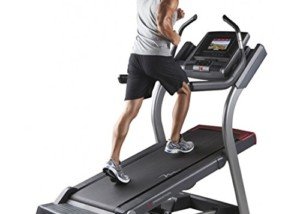If you see everyone in your group treadmill class holding onto the machine, does this mean you should too?
The answer is NO. Absolutely NOT.
It’s entirely possible for the vast majority of people in a specific setting to be wrong.
And in the case of nearly everyone in a group treadmill class hanging onto the machine, they are wrong (with the exception of those with physical impairments that necessitate assistance walking in everyday life).
What may happen is that a newcomer to treadmill use joins a group class that includes treadmill work.
That individual looks around to see what everyone else is doing, and notices that seemingly everyone is holding onto the treadmill.
That individual, a follower more than an independent thinker, thus holds on without a second thought.
However, this begs the question: Where did everyone else in the class get the idea to hold on?
Most novice exercisers will instinctively hold onto a treadmill. Interestingly, many veteran exercisers continue to do this after years of using a treadmill.
Plus, many who hold on are plenty experienced in weight training involving the lower body (which makes it even weirder that they would feel a need to hold onto a treadmill).
My brother-in-law, who used to play a lot of basketball and hockey in corporate leagues, clings to a treadmill during his Orangetheory classes.
Thus, it’s clear that this longstanding epidemic of incorrect treadmill use has nothing to do with disability.
One day I saw a young man with Down syndrome using a treadmill without holding on. And one day I spotted a karate instructor grasping the console. Very intriguing.
Proper Way to Use a Treadmill
Whether you’re in a group class or not, you should walk (or jog) without holding on, unless you need assistance walking in everyday life, like the stroke survivor I once worked with on a treadmill who relied on a four-pronged cane in everyday life.
When it’s time to drink water, change the settings or do some other visually distracting task, then yes, hold the machine to keep steady.
But once you’re done with the task (including heart rate check), then let go and move your arms naturally at your side, the way you would if walking on a trail or track.

Cons of Holding onto a Treadmill
• Burns far fewer calories (the calorie display is generated by the settings, not the user).
• Teaches the body to depend on external support for steadiness.
• Mimics using a walker.
• Disrupts posture and natural gait.
• Can result in repetitive stress injuries of the joints.
• Yields a false sense of achievement. E.g., holding on at 3 mph and 15 percent incline will NOT, in the very least, transfer over to an outdoor hill hike.
If you think it does, you’ll be in for a shock when you walk hills outdoors at 3 mph.
Funny thing, though, people often think that 3 mph on a treadmill is the same speed they walk a hill.
But even a 2 mph sustained hill walk will be difficult for a person who’s been hanging onto a treadmill at 3 mph.
If everyone in your group class is holding onto their treadmill, do not copy this sabotaging habit.
Perhaps you can set an example and encourage the others to do real walking instead of pretend-walking.
If you feel off-balance, then use a slow speed to train your body to navigate a moving tread without holding on for support.
Once you get use to a slow speed, then gradually increase it.
Humble yourself and give up the super high incline and jack rabbit speed so that you can learn to walk the way your body is supposed to.



























